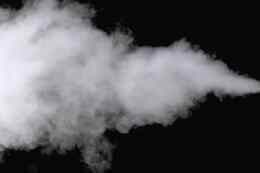Get to know the working principle of psychrometry. Make a similar measurement with the thermometer in the test set yourself and determine the air humidity based on this. The worksheet also has a calculator for determining air humidity. If possible, compare the result with the reading of an industrially produced air humidity meter.
The classic, psychrometric method of determining air humidity combines two phenomena related to evaporation.
A) Evaporation intensity is related to air humidity. Everyone knows that drying (evaporation of water from things, clothes, people) happens much faster in dry weather. At 100% air humidity, for example, laundry does not dry at all. There are also other phenomena that can be very helpful when drying laundry, such as sunshine and wind. Measuring instruments try to keep these interfering phenomena under control so that evaporation is determined only by air humidity.
B) Evaporation takes energy, and when water evaporates from the body, it cools. For example, we know that we get cold in wet clothes. In total, this means that a wet body must cool more in dry air than in moist air, all other conditions being equal.
The psychrometer consists of two thermometers: one is dry, the other is kept constantly wet. A simple means of moistening a liquid thermometer is a wet cloth wrapped around the reservoir and held upside down in water. If the air is saturated with water vapor (air humidity 100%), the water does not evaporate from the wet cloth, the wet thermometer does not cool down and shows the temperature of the surrounding environment together with the dry one. If the relative humidity is lower, water will evaporate from the wet thermometer, it will cool and there will be a difference in the temperature readings. The drier the air, the greater the difference. The psychrometer comes with a corresponding table, which can be used to find the humidity corresponding to the temperature difference.
Especially controlled conditions are created in psychrometers used for accurate meteorological observations and for calibrating other hygrometers. The air movement speed around the thermometers is kept exactly equal by the fan and the thermometers are separately protected from any external heat radiation.
Chilled mirror. The dew point - the temperature at which water vapor in the air begins to condense - is well suited for calibrating hygrometers. The beginning of condensation (dew falling) can be seen very well on the mirror surface. To determine the dew point, the temperature of the cooled mirror is measured exactly at the moment of condensation. Mirror fogging can be determined by careful observation, but there are also electronic methods. The absolute humidity corresponding to the dew point can be found in the table. In the case of electronic devices, the table is of course in computer memory. Hygrometers of this type are often used in laboratories, because although they are quite accurate and reliable, they also require maintenance and cleaning. The results can be disturbed by, for example, dust and other air pollution.
Katse andmed
| Kuiva termomeetri temperatuur | ∘C |
| Kuiva ja märja termomeetri näitude erinevus | ∘C |
| Õhuniiskus minu katse tulemuste põhjal | |
| Õhuniiskus tööstusliku õhuniiskuse mõõtjaga mõõdetuna |
The calculator calculates relative humidity based on the readings of the dry and wet thermometers of the psychrometer. See below for the formula used in the calculator. When using the calculator, enter the data in the table. The answer appears in the last row of the table.
Air humidity according to the readings of the psychrometer thermometers
| Dry thermometer temperature | ∘C |
| Wet thermometer temperature | ∘C |
| Relative humidity |
A psychrometer consists of two thermometers. One is dry, the other is kept constantly wet. A simple way to moisten a liquid thermometer is to wrap a wet cloth around the reservoir and hold it upside down in water. If the air is saturated with water vapor (humidity 100%), the water does not evaporate from the wet cloth, the wet thermometer does not cool down and shows the temperature of the surrounding environment together with the dry one. If the relative humidity is lower, the water from the wet thermometer starts to evaporate, it cools and there is a difference in the temperature readings. The drier the air, the greater the difference. The psychrometer comes with a corresponding table where you can find the humidity corresponding to the temperature difference.
Here we use the following formula to calculate relative humidity
where
and
Source: https://www.1728.org/relhum.htm
Intermediate results:

